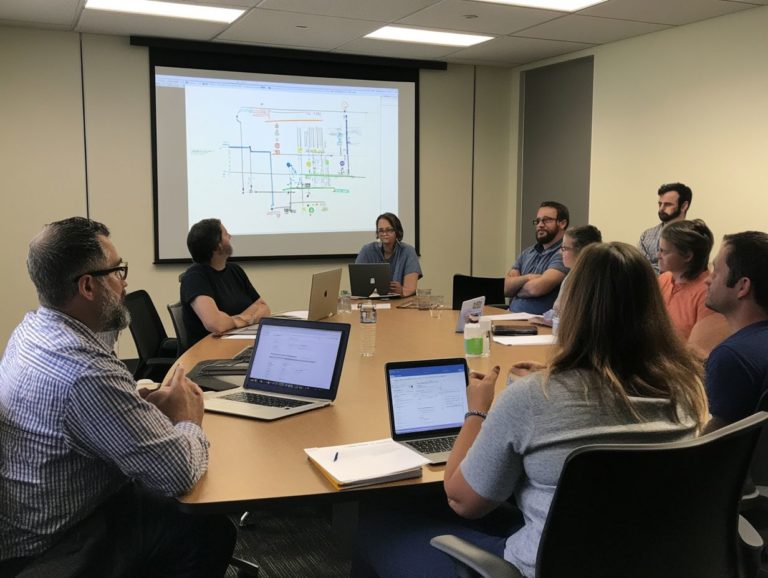“5 Key Metrics to Track CRM User Training Success”
In today s fast-paced business world, harnessing your Customer Relationship Management (CRM) system effectively is crucial for thriving. A well-structured CRM user training program boosts user adoption, minimizes errors, and enhances data quality.
This article delves into five key metrics that can help you evaluate the success of your CRM training initiatives. From understanding user adoption rates to improving customer satisfaction, you ll find insights that can transform your approach to CRM training and propel your business forward. Act now to boost your CRM effectiveness!
Contents
- Key Takeaways:
- 1. Increase in User Adoption
- 2. Decrease in User Errors
- 3. Improvement in Data Quality
- 4. Reduction in Training Time and Costs
- 5. Improved Customer Satisfaction
- Why Is Tracking CRM User Training Success Important?
- What Are the Key Metrics to Track for CRM User Training Success?
- How Can User Adoption Be Measured?
- What Are Some Common User Errors and How Can They Be Tracked?
- How Can Data Quality Be Measured and Improved?
- What Are the Ways to Reduce Training Time and Costs?
- How Can Customer Satisfaction Be Measured and Improved?
- Frequently Asked Questions
Key Takeaways:
- Increased user adoption shows confidence in system usage.
- Fewer user errors indicate effective training.
- High data quality supports better decisions.

1. Increase in User Adoption
Maximizing user adoption of your CRM software is crucial for your business success. It directly impacts team engagement, customer success, and the overall performance metrics of your business.
A successful CRM implementation hinges not just on the software’s features but also on the training and resources that empower you to leverage its capabilities effectively. By cultivating a culture of acceptance and using data to understand, you can enhance user adoption rates, ensuring that every team member is equipped to meet and exceed defined SMART goals for customer engagement and retention.
To further elevate user engagement, consider investing in tailored training sessions and accessible support resources that cater to the diverse expertise levels within your team.
Regularly measuring success through specific metrics like user login frequency, feature utilization rates, and direct feedback scores enables you to quickly adjust your strategies. Implementing robust feedback mechanisms, such as surveys and one-on-one check-ins, can yield invaluable insights into user experience.
2. Decrease in User Errors
A decrease in user errors within CRM systems elevates data integrity and enhances team performance and customer engagement.
Misusing the system can lead to miscommunication and lost opportunities. Identifying and tracking these common errors is essential and creates a clear roadmap for corrective actions.
For example, users might struggle with data entry or forget to update records, leading to distorted reporting and forecasting efforts. Implementing targeted training sessions designed to address specific weaknesses can empower you and your team.
Establishing regular feedback loops fosters an environment of continuous improvement. Cultivating a culture of accountability and learning reduces mistakes and contributes to a more effective and reliable CRM system overall.
3. Improvement in Data Quality

Improving data quality in your CRM systems is essential for accurate reporting, effective governance, and extracting actionable insights that fuel business growth and enhance customer retention. It is pivotal for ensuring you have precise and up-to-date information readily available.
Key components such as accuracy, completeness, and consistency are fundamental to achieving high-quality data. Accuracy guarantees that the information reflects real-world scenarios, while completeness ensures all necessary data points are captured. Consistency is vital for maintaining uniformity across different systems, crucial for seamless integration.
To track and enhance data quality, implement regular audits, establish robust validation processes, and follow best practices in data governance. These strategies safeguard the integrity of your data and cultivate a culture of accountability and continuous improvement.
4. Reduction in Training Time and Costs
Reducing training time and costs boosts user adoption and optimizes how you use resources. This enhances your team’s productivity.
By implementing structured onboarding, you can make the initial learning curve smoother. Users will grasp essential features quickly.
Using technology for training like interactive e-learning or virtual reality creates a fun experience that suits different learning styles.
These strategies cut training time and build user confidence, leading to greater satisfaction.
Financial savings from reduced training hours can be redirected to other critical areas. This significantly benefits your organization s bottom line.
5. Improved Customer Satisfaction
Effective CRM usage boosts customer satisfaction. This leads to higher NPS scores, increased retention rates, and better business performance.
This highlights the importance of using customer relationship management tools. They help you understand customer needs and preferences, not just track interactions.
Focusing on metrics like the Net Promoter Score (NPS) tells you how likely customers are to recommend your services. This serves as a clear indicator of their satisfaction.
Using continuous feedback tools like surveys or regular check-ins helps you quickly adapt to changing customer perceptions. These efforts build loyalty and create meaningful conversations with your clients.
Why Is Tracking CRM User Training Success Important?

Tracking the success of your CRM user training is crucial. It shows how effective your training programs are and ensures your teams meet performance goals.
Diving into key metrics helps you identify areas for improvement. This can refine your training processes and encourage a culture of continuous learning.
Monitoring indicators like training feedback and time to competency gives you a clear picture of training effectiveness. It reveals how well users are learning.
Gathering training feedback allows you to adjust content to better meet user needs. Tracking how long it takes to achieve competency shows training efficiency.
Assessing how training impacts customer engagement highlights the benefits of investing in employee development. You ll see a direct link between well-trained staff and great client interactions.
What Are the Key Metrics to Track for CRM User Training Success?
Key metrics to monitor for CRM user training success include user engagement, performance indicators, and feedback methods. These provide valuable insights into training effectiveness.
User adoption rates are essential, as they show how quickly employees start using the CRM. This offers a clear view of training impact.
Training satisfaction scores reflect how well the content resonates with participants. Tracking performance improvements helps determine if users meet their goals with the software.
By analyzing these metrics, you can improve training strategies. Address any gaps and enhance future sessions to better equip users. This leads to more successful CRM use in your organization.
How Can User Adoption Be Measured?
User adoption can be effectively gauged through a variety of metrics, including usage frequency, engagement levels, and the feedback you gather from users about their experiences with the Customer Relationship Management (CRM) system.
By analyzing numbers and statistics such as how often team members log in and how extensively they utilize various features you can uncover valuable insights into how well your teams are integrating the system into their daily operations.
Qualitative methods like user surveys can reveal deeper sentiments about the system. This helps you identify areas where users might be struggling or excelling.
Acting on these insights allows you to craft tailored training sessions or support initiatives. This creates a more intuitive experience that meets specific user needs and ultimately boosts adoption rates.
What Are Some Common User Errors and How Can They Be Tracked?

Common user errors in CRM systems often include data entry mistakes, navigation issues, and underutilization of features. Tracking and analyzing these errors offers a pathway to enhancing both training and system usability.
Identifying these challenges systematically provides invaluable insights into how users interact with the system. For example, leveraging error logs allows you to pinpoint the most frequent issues, while user feedback offers a rich, qualitative understanding of the challenges faced.
Analytics tools can reveal patterns in user behavior, illuminating whether certain features are being underused. This information is crucial for developing targeted training programs that address these gaps, leading to improved data quality and a more efficient use of the CRM system.
How Can Data Quality Be Measured and Improved?
Data quality in your CRM system can be assessed through various metrics such as accuracy, completeness, and consistency. These factors are crucial for ensuring that the information supports effective decision-making.
Employing methods like regular audits and validation checks provides valuable insights into the reliability of your data. Audits offer a systematic review of your existing data sets, identifying discrepancies and areas that need attention. Meanwhile, validation checks ensure that data meets established criteria before it enters the system.
To elevate data quality further, it s essential to implement robust governance processes. Establishing clear guidelines and accountability can make a significant difference. Investing in user training equips your team with the skills necessary to maintain data integrity.
By embracing these best practices, you ll cultivate a culture of data quality awareness throughout your organization.
What Are the Ways to Reduce Training Time and Costs?
Reduce training time dramatically by implementing effective strategies like streamlining your onboarding processes and leveraging digital training resources.
Incorporating e-learning modules gives users the power to learn at their own pace, minimizing the need for extensive in-person training sessions. This flexibility not only saves time but also accommodates various learning styles, ultimately enhancing user engagement.
Establishing mentorship programs gives new users access to experienced staff. This fosters a collaborative environment that promotes quicker troubleshooting and skill development.
Providing ongoing support resources such as easily accessible FAQs and video tutorials ensures users have the necessary tools at their fingertips.
By combining these approaches, you can greatly enhance user adoption and the overall effectiveness of your CRM system, leading to a more efficient organization.
How Can Customer Satisfaction Be Measured and Improved?
You can measure customer satisfaction using metrics like the Net Promoter Score (NPS), which measures how likely customers are to recommend your product to others, feedback surveys, and engagement analytics. These tools help you understand your audience’s needs better.
Surveys provide quantitative data to identify strengths and weaknesses in your product. Feedback forms invite customers to share their thoughts in detail.
Monitoring engagement rates on digital platforms helps you see how well your audience connects with your brand. Analyzing these metrics allows you to create targeted improvement strategies, whether that means refining features or enhancing support.
This leads to a more rewarding and loyal customer experience!
Frequently Asked Questions
What are the 5 key metrics to track CRM user training success?
The 5 key metrics are user engagement, knowledge retention, performance improvement, time-to-competency, and overall satisfaction.
How can user engagement be measured?
You can measure engagement through attendance rates, participation in activities, task completion, and feedback surveys.
What is knowledge retention and how is it measured?
Knowledge retention is how well users remember the skills learned during CRM training. You can measure it through assessments, quizzes, and practical assignments.
How can performance improvement be tracked?
Track performance improvement with important measures like increased sales, improved customer satisfaction, and reduced error rates. Define and monitor these before and after training.
What is the ideal time-to-competency for CRM user training?
The ideal time-to-competency can vary, but a timeframe of 4-6 weeks is generally recommended.
How can overall satisfaction be measured?
You can measure overall satisfaction through feedback surveys and one-on-one interviews, providing valuable insights into the training program’s effectiveness.






